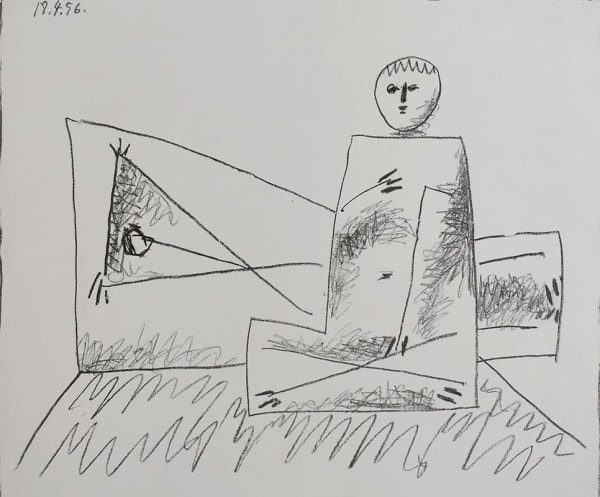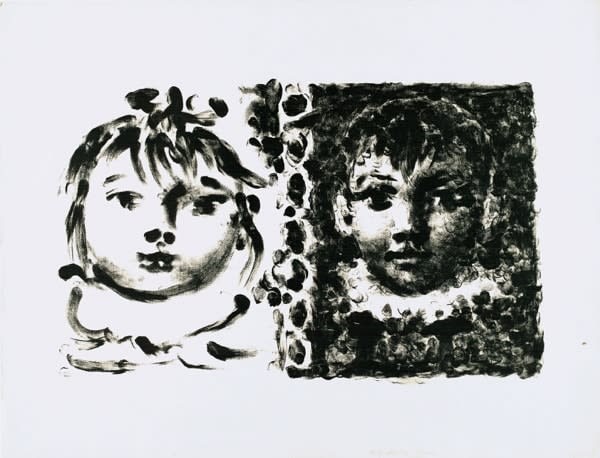-
Artworks

Pablo Picasso
Françoise Sur Fond Gris, 1950Lithograph on gray-blue laid Ingres Canson paper with the Ingres Canson watermark24 7/8 x 18 7/8 in
63.2 x 47.9 cmEdition of 50 and 5 artist proofsSeries: LithographCopyright The ArtistFrançoise sur fond gris (Françoise on a Grey Background) is a compelling lithograph by Pablo Picasso, created in 1946 at the dawn of one of the most prolific and emotionally...Françoise sur fond gris (Françoise on a Grey Background) is a compelling lithograph by Pablo Picasso, created in 1946 at the dawn of one of the most prolific and emotionally charged periods of his life. This portrait of Françoise Gilot—Picasso’s lover, muse, and a remarkable artist in her own right—captures the convergence of tender observation and stylistic experimentation that defines Picasso’s post-war work. More than a portrait, the lithograph is a masterclass in graphic technique, emotional intensity, and psychological depth.
The work depicts Françoise in a half-frontal pose, her hand resting against her face. The composition is dominated by bold contrasts: the figure’s luminous face and hand are dramatically set against a rich, dark, heavily worked background. This tonal interplay creates a strong focal point, drawing attention to her reflective, enigmatic expression.
The face is stylised yet unmistakably human. Picasso combines expressive realism with subtle distortions: the eyes are asymmetrical and wide, the nose sharply divided by a line of light, and the mouth rendered with full, sensuous lips. This stylisation is typical of Picasso’s evolving approach to portraiture—never strictly literal, but instead aiming to convey emotional and psychological truth. The linear structure, especially in the hair and garment, uses dense crosshatching and layered textures to contrast with the smooth, volumetric modeling of the skin.
The lithographic technique allows for extraordinary nuance. The tonal gradations, soft edges, and build-up of texture demonstrate Picasso’s absolute command of the medium. He pushes the stone’s surface to its expressive limits, blending drawing, painting, and sculpture into a single, two-dimensional form.
While Picasso is best known for his paintings and sculpture, his achievements in printmaking are equally groundbreaking. Throughout his career, he explored etching, aquatint, linocut, and especially lithography—each medium offering unique possibilities for mark-making and repetition. The lithograph became especially important during his time at the Atelier Mourlot in Paris in the 1940s and 1950s, where he collaborated with master printer Fernand Mourlot.
Françoise sur fond gris is emblematic of this fruitful period. Unlike etching or woodcut, lithography allowed Picasso to draw directly onto the stone with grease pencils, giving him the freedom to render subtle tones, broad washes, and painterly gestures. It became a perfect vehicle for his expressive portraiture, particularly in capturing the nuances of his emotional relationships.
Françoise Gilot was Picasso’s partner from 1943 to 1953 and the mother of two of his children, Claude and Paloma. Their relationship was one of mutual artistic stimulation—she was not only a muse but also a formidable painter who would later author Life with Picasso, an important firsthand account of his personality and studio life.
In this lithograph, Picasso’s representation of Françoise is intimate yet monumental. There is tenderness in the gaze and elegance in the hand’s gesture. Unlike his more aggressive or abstract depictions of other lovers, this image projects balance and introspection. It stands as a rare moment of emotional equilibrium in Picasso’s often stormy personal narrative.
Françoise sur fond gris demonstrates Picasso’s brilliance not just as a painter and sculptor, but as a printmaker who transformed the possibilities of the medium. With exquisite tonal control, psychological depth, and compositional economy, the lithograph encapsulates his ability to fuse technical mastery with human insight. It is both a love letter and an artistic manifesto—an enduring testament to the richness of Picasso’s graphic work.
For more information, contact our galleries via the inquiry form below.
%3Cdiv%20class%3D%22artist%22%3EPablo%20Picasso%3C/div%3E%3Cdiv%20class%3D%22title_and_year%22%3E%3Cspan%20class%3D%22title_and_year_title%22%3EFran%C3%A7oise%20Sur%20Fond%20Gris%3C/span%3E%2C%20%3Cspan%20class%3D%22title_and_year_year%22%3E1950%3C/span%3E%3C/div%3E%3Cdiv%20class%3D%22medium%22%3ELithograph%20on%20gray-blue%20laid%20Ingres%20Canson%20paper%20with%20the%20Ingres%20Canson%20watermark%3C/div%3E%3Cdiv%20class%3D%22dimensions%22%3E24%207/8%20x%2018%207/8%20in%3Cbr/%3E%0A63.2%20x%2047.9%20cm%3C/div%3E%3Cdiv%20class%3D%22edition_details%22%3EEdition%20of%2050%20and%205%20artist%20proofs%3C/div%3E%3Cdiv%20class%3D%22series%22%3E%3Cspan%20class%3D%22artwork_caption_prefix%22%3ESeries%3A%3C/span%3E%20Lithograph%3C/div%3ERelated artworks-
 Pablo PicassoLe Corsage à Carreaux, 1949
Pablo PicassoLe Corsage à Carreaux, 1949 -
 Pablo PicassoGrand Maternite, 1963
Pablo PicassoGrand Maternite, 1963 -
 Pablo PicassoJacqueline Profile to the Right, 1958
Pablo PicassoJacqueline Profile to the Right, 1958 -
 Pablo PicassoLes Demoiselles d'Avignon, 1953
Pablo PicassoLes Demoiselles d'Avignon, 1953 -
 Pablo PicassoBuste au fond étoilé (Bust with Star Background), 1949
Pablo PicassoBuste au fond étoilé (Bust with Star Background), 1949 -
 Pablo PicassoJeu De La Cape (Bloch 1015), 1961
Pablo PicassoJeu De La Cape (Bloch 1015), 1961 -
 Pablo PicassoTete De Femme Fond Noir, 1946
Pablo PicassoTete De Femme Fond Noir, 1946 -
 Pablo PicassoBuste de Femme au Corsage Blanc (Jacqueline de Profil), 1957
Pablo PicassoBuste de Femme au Corsage Blanc (Jacqueline de Profil), 1957 -
 Pablo PicassoReclining Man and Crouching Woman | Homme couché et femme accroupie, 1956
Pablo PicassoReclining Man and Crouching Woman | Homme couché et femme accroupie, 1956 -
 Pablo PicassoThe Little Artist (Draughtsman) | Le petit dessinateur, 1954
Pablo PicassoThe Little Artist (Draughtsman) | Le petit dessinateur, 1954 -
 Pablo PicassoFemme à L'Italienne d'après le tableau de Victor Orsel (Bloch 740), 1953
Pablo PicassoFemme à L'Italienne d'après le tableau de Victor Orsel (Bloch 740), 1953 -
 Pablo PicassoGrand Nature Mort au Compotier, 1947
Pablo PicassoGrand Nature Mort au Compotier, 1947 -
 Pablo PicassoAfter The Embrace, 1901
Pablo PicassoAfter The Embrace, 1901 -
 Pablo PicassoProfil de Femme
Pablo PicassoProfil de Femme -
 Pablo PicassoProfil au fond noir, 1947
Pablo PicassoProfil au fond noir, 1947 -
 Pablo PicassoRonde de la Jeunesse, 1961
Pablo PicassoRonde de la Jeunesse, 1961 -
 Pablo PicassoFemme à la Robe
Pablo PicassoFemme à la Robe -
 Pablo PicassoJacqueline with Roses, 1956
Pablo PicassoJacqueline with Roses, 1956 -
 Pablo PicassoPaloma et Claude, 1950
Pablo PicassoPaloma et Claude, 1950 -
 Pablo PicassoBuste, 1957
Pablo PicassoBuste, 1957 -
 Pablo PicassoPortrait de Femme II, 1955
Pablo PicassoPortrait de Femme II, 1955 -
 Pablo PicassoTête de Jeune Fille – Portrait de Françoise, 1949
Pablo PicassoTête de Jeune Fille – Portrait de Françoise, 1949 -
 Pablo PicassoJeunesse, 1950
Pablo PicassoJeunesse, 1950
-
Join our mailing list
* denotes required fields
We will process the personal data you have supplied in accordance with our privacy policy (available on request). You can unsubscribe or change your preferences at any time by clicking the link in our emails.
This website uses cookies
This site uses cookies to help make it more useful to you. Find out more about cookies.























